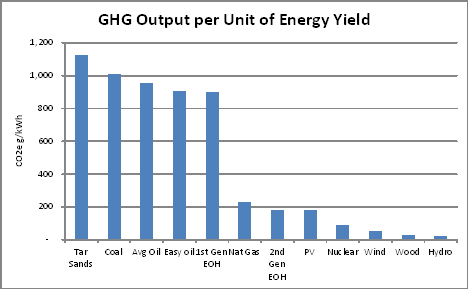A Hard Look at Energy Choices
Stephen Hood, P.Eng., CEM, LEED AP
There is so much talk about which conventional energy sources are better or worse for the environment, whether renewable sources are truly renewable, now much impact we can expect from wind, solar or biomass energy, and so on.
The following data was provided by Robert Rapier, a recognized expert on issues around peak oil. Robert was the keynote speaker at a conference I attended Nov 10, 2010 at the University of Guelph. This chart shows the energy yield ratio of different fuel sources. That is: units of useful output per unit of energy input.

It seems to be well known that 1st generation ethanol, that is, ethanol from corn grain requires as much input as it yields in output, hence a 1:1 ratio. Not good at all. The tar sands at 4 is not surprising either. Second generation ethanol from switchgrasses and other biomass sources promise to have a positive yield of renewable energy. Note that in most of these cases the energy input requirement is assumed to be fossil fuel based.
I didn't find this chart to be very informative, because although it is good at showing energy yield ratios, it is not helpful if we want to see the overall global warming (GHG) impacts of these fuel choices. What we should really be doing is combining the known GHG emission factors with the yield data for each of these sources to arrive at an overall GHG impact considering the energy inputs, outputs and yield ratios. This approach allows us to lend some real clarity and see which fuels are the dirtiest or cleanest. Ok, so here it is:

The news is not good for tar sands oil, coal or any other oil. First generation ethanol is just as bad. Why? Because at a 1:1 yield ratio and the input being fossil fuel based (farm machinery, fertilizer production, transportation), then the GHG impact is in the same range as the fossil fuels. So why has US energy policy mandated the use of ethanol in motor fuels? Let's leave that alone for now.
Moving across the chart we now see what we probably expected to see. Most of the renewable fuel sources are very good. PV and 2nd generation ethanol are not as good because their yields are lower in the first place. Surprisingly a non-renewable fuel is good - Nuclear. Wood or other biomass are much better than ethanol, however the end-use will be much different with biomass being used for heat or electricity, and ethanol for transportation. Natural Gas, although non-renewable and higher impact than renewables, is much better than oil or coal. Possibly it can be considered as a good interim alternative while we research and improve renewable technologies. A warning would be on potential collateral environmental impacts which are not considered here. There are many of them: the fracking process of producing shale gas, the air quality impacts of burning biomass, the land and water environmental impacts of nuclear and hydroelectric energy, not to mention the additional land and water impacts for already unattractive fossil fuels.
So what conclusions can be drawn from this analysis?
1. We should be focussing on clean energy alternatives where ever possible. Grants and incentives are a major factor influencing the viability of renewable projects; we need to maximize them to make such projects work.
2. There should be some urgency to develop next generation bio-fuel technologies, and leave corn as a food stock, not a fuel. Biomass is second best on the chart!
3. Natural Gas is much preferred over oil and coal, but being non-renewable will only be an short to medium term solution to reducing GHGs. The recent trends toward low cost of gas resulting from over-supply present some very interesting opportunities, especially for natural gas fired co-generation.
4. Photovoltaic power does not compare favourably with wind, biomass and hydro energy sources.
This somewhat simplistic analysis helps point towards energy alternatives which can make a difference in combating climate change. What it does not do however is reflect the supply infrastructures necessary for these alternatives to become viable, the levels of capital investment required for fuel refinement and at points of end-use, the lifecycle economics of each one, nor the scale to which they are implementable and can help offset conventional fuel GHG impacts. These considerations become very specific to each fuel and end-use application.
If you have comments, questions or enquiries please contact: shood@aerasolutions.com
